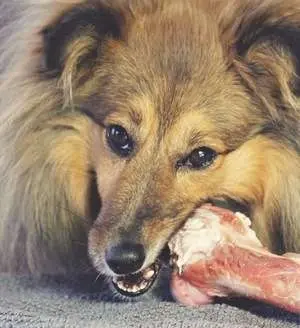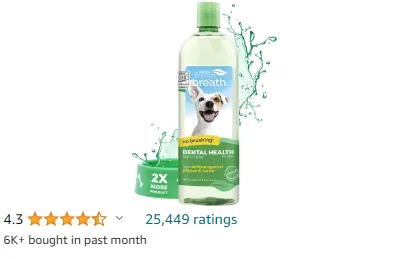Feeding your Sheltie can be as simple as grabbing the cheapest bag of kibble from the supermarket. However, cheap kibbles rely too heavily on grains rather than protein which is what dogs thrive on. There are also well-established concerns about additives and the source of meat.
QUICK TAKE: If you choose to feed dry dog food, select a high quality kibble with meat as the primary ingredient and look for natural preservatives and essential vitamins. Vets recommend brands like Hill's Science Diet and Blue Buffalo Life.
The Scale of Dry Dog Food
Dry kibble may look and smell the same to us humans, but looks can be deceiving. In fact, the scale of dog food is broad, and price is a valuable indicator of what you're actually feeding your Sheltie.
Despite the glossy branding, many cheap and mid-range kibble brands use corn, soy, and meat by-products as the bulk ingredients, which leave your Sheltie undernourished. This can lead to all kinds of skin, bone, joint, and heart problems as she ages. As a rule of thumb: if the first item in the ingredients list is corn or meat and bone meal, this is a red flag.
In contrast, premium kibble brands contain good quality meat, which allows the manufacturer to specify beef, lamb, or poultry meal as the primary ingredient. This is supplemented with essential vitamins and minerals like Omega-3 fatty acids which have many beneficial roles in the body, from the immune system to heart function.
Let's dive into the details with a breakdown of the best and worst ingredients in dog food. Broadly speaking, we want to consider two aspects:
The Source of Meat. It's no secret that cheap kibble contains some dubious sources of meat. Sickeningly, these sources include diseased farm animals, euthanized pets, and road kill. Dog food manufacturers can also legally use any kind of slaughterhouse by-product, including animals treated with hormones and other drugs not destroyed by the cooking process.
The Meat vs Grain Ratio. In recent decades, some major dog food manufacturers have turned to using grain as the main ingredient, leaving high protein meat as an afterthought. Your Sheltie's ancestors evolved eating raw meat and bones, with a little vegetation from the belly of their prey, and we should try to replicate this diet where possible. A high-grain diet is woefully inadequate.
6 Bad Dog Food Ingredients
Here are six specific ingredients to avoid, especially when they appear near the top of the ingredients list, which signifies the highest proportion. This applies to dog kibble as well as dental chews and treats.
AVOID: Meat and Bone Meal. This is a generic term for ground up meat and bones from a number of animal species, including diseased livestock, euthanized pets, and road kill. Where animals were treated with antibiotics or steroids before they died, those become part of the dog food too.
AVOID: Meat By-Products. This refers to slaughterhouse material not deemed fit for human consumption: intestines, heads, feet, hides, and bones. As this includes diseased and contaminated meat, all meat by-products go through an intensive cooking process which destroys the nutrients and proteins.
AVOID: Poultry By-Product Meal. This is the same deal, except with poultry. Poultry by-products—such as bills, feathers, necks, feet, eggs, and intestines—contain little meat, and once again can include diseased and contaminated materials as well as harmful chemical additives.
AVOID: Propylene Glycol. This is a synthetic preservative which is proven to cause red blood cell damage in cats. There is insufficient data to determine if it's also toxic to dogs, but I err on the side of caution, especially when it's a component of their daily diet.
AVOID: Ethoxyquin. This is another chemical additive, listed as a pesticide by the Department of Agriculture. It's an illegal additive in human food because of proven links to cancer of the kidneys, bladder, and stomach. Any kibble containing fish meal contains some ethoxyquin that's present in the food chain.
AVOID: BHA & BHT. While banned in most European countries, these artificial additives are still legal in the US. BHA and BHT are known to cause liver and kidney dysfunction, as well as bladder and stomach cancers. The cumulative toxicity from daily consumption is a real concern.
4 Good Dog Food Ingredients
What do we want to see at the top of the ingredients list? Here are four ingredients to look for:
SEEK: Beef, Lamb, or Poultry Meal. When the type of animal meat is specified, you know it's coming from a reliable source. Don't be afraid of the term meal having seen it in the last list: meal just means ground-up. Quality dog food contains at least one type of meat or poultry meal as the main ingredient.
SEEK: Omega-3, Taurine, and Flaxseed Oil. Taurine helps prevent blindness and heart disease, while flaxseed oil improves the skin and coat, and protects against degenerative diseases and illness. Omega-3 is an essential fatty acid that reduces inflammation and promotes healthy skin.
SEEK: Vitamin E, Vitamin C and Tocopherols. These are natural preservatives which help retain the fat in dry dog food. They're the preferred alternatives to ethoxyquin mentioned earlier.
SEEK: Trace Minerals in Chelated Form. Chelation is a process that converts trace minerals into a form that's more effectively absorbed in the intestinal tract and bloodstream. Chelated minerals are the ideal form to properly nourish your dog.
It's never too late to improve the quality of your Sheltie's diet. If you're feeling overwhelmed, we feed our Shelties Hill's Science Diet which is designed for dogs with sensitive stomachs while targeting optimal nutrient absorption. It's also the number one dog food recommended by vets.
Feeding Fresh Dog Food
Some people choose to feed their dogs an entirely fresh food diet because the nutrients are more readily absorbed. What's more, chewing on raw bones, along with the bacteria and enzymes present, can improve oral health. Raw food proponents also say their dogs have shinier coats, healthier skin, and more energy.
A fresh food diet may be particularly beneficial for dogs with allergies, weight issues, and digestive problems related to processed kibble. However, there are some caveats. Vets point out that the bacteria in raw dog food pose an added risk to young children and people with compromised immunity. Always take meticulous care when preparing raw meat and bones to avoid contamination. What's more, young puppies and dogs suffering from serious health issues may not be able tolerate the bacteria in raw foods.
If you do decide to try a raw dog food diet, get a supply of raw meaty bones from the butcher and freeze what you don't plan to use in the next few days. Bones are cheap, great for cleaning your dog's teeth, and great for mental stimulation. The bones and muscle meat that remains attached provide a number of essential nutrients, as well as good quality protein. As a general rule, offer your Sheltie about 20% of her body weight in raw meaty bones per week.
For example, a Sheltie that weighs 20lbs (9kg) should eat 4lbs (1.8kg) of meaty bones per week, which is about 9oz (255g) per day. Adjust this up or down depending on her age and activity level, as younger dogs can eat more and burn it off during exercise. Add a small amount of table scraps and treats, including organ meat, muscle meat, dog-safe fresh fruits and vegetables, and a limited amount of dairy.

Feed 20% of your dog's bodyweight in raw meaty bones each week.
30 Foods That Are Toxic to Dogs
Even common foods like grapes, onions, tomatoes, and avocados can be toxic to dogs, causing anything from stomach upset to death. Make a note or print out these 30 common foods and avoid feeding them as scraps or as part of a raw food diet.

A number of common human foods are not fit for your Sheltie.
Taking Care of Your Dog's Teeth
Look after your dog's oral health, especially if you feed dry dog food which can stick in small spaces between the teeth. In doing so, you'll spare him the pain of cavities and surgical tooth extractions down the line. Here are the best three ways to care for your Sheltie's teeth:
1. Brush Your Dog's Teeth
The best way to care for your Sheltie's teeth is to brush nightly with a dog toothbrush and a dog toothpaste. It's always awkward at first, but repeat exposure will get him used to the sensation of the brush in his mouth. And it's absolutely worth the fuss (just Google image search "dog tooth decay" and you'll see why).
2. Offer Dental chews
If you don't plan to brush your dog's teeth every day, brushless alternatives are designed to stop plaque and tartar before they start, while forming a protective layer on the teeth. Dental chews mechanically loosen existing tartar while stimulating saliva to protect against plaque forming.
3. Use Liquid Plaque Remover
Besides toothbrushing and/or dental chews, consider using a water additive that serves as a natural mouthwash. Designed for your dog's water bowl, water additives are safe to drink and stay in the saliva for hours, fighting plaque and tartar. Extra measures like this can reduce the likelihood of painful cavities and tooth extractions down the line.
Final Thoughts
Whether you feed your Sheltie a premium dry kibble or raw meaty bones, the best dog food is one that's been well-considered by his owner. So thank you for taking the time to learn a little more about dog nutrition. And remember, fresh water is an essential for any diet, so make sure your dog has a clean source of water at all times.
















